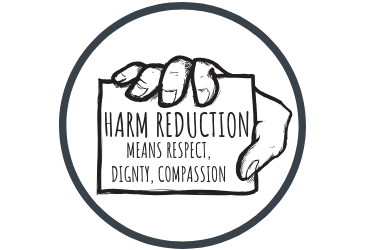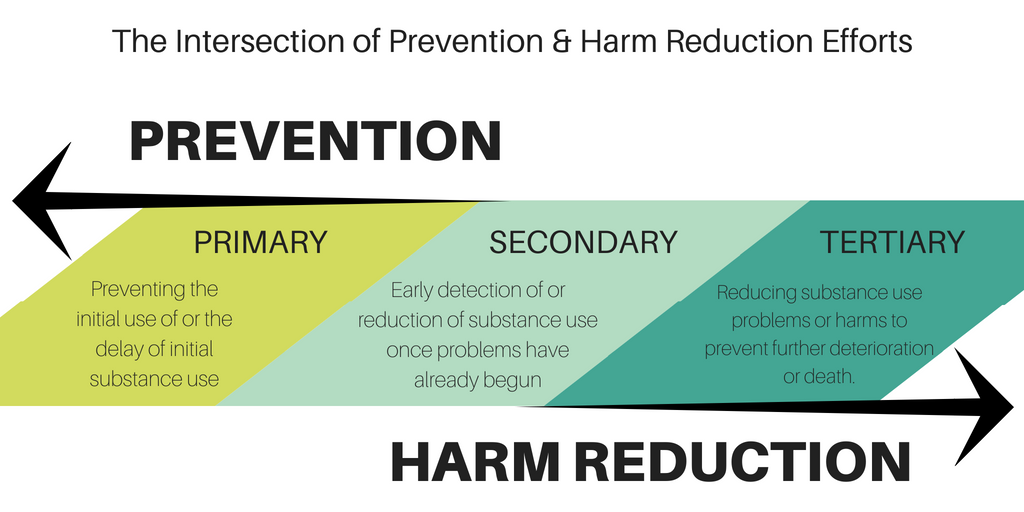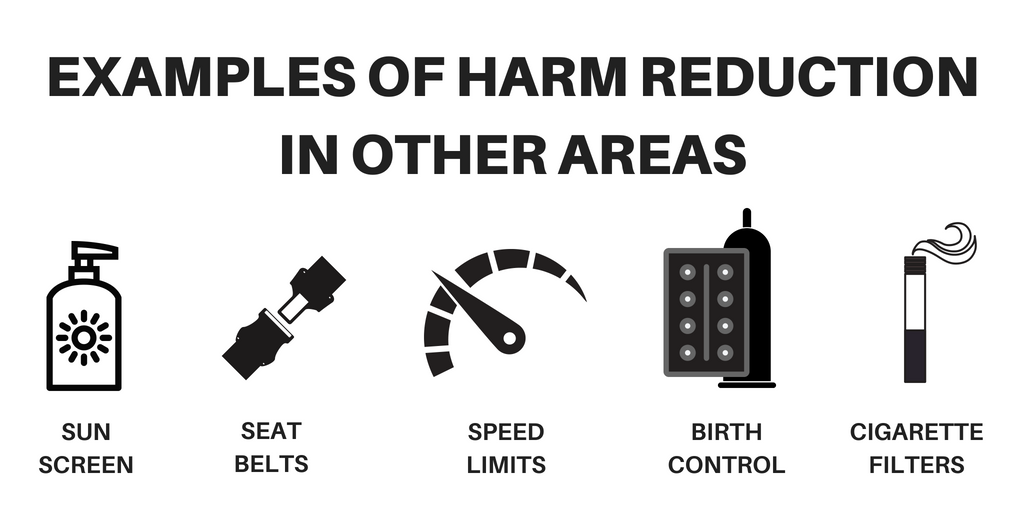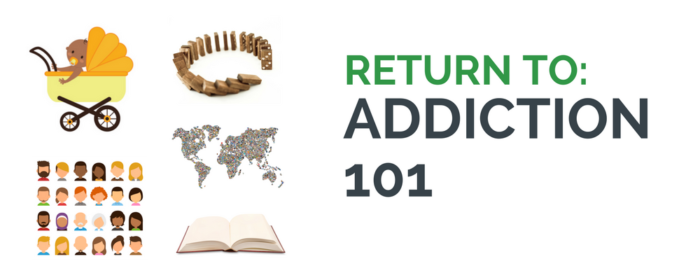
Harm Reduction
Policies, programs, and practices that aim to reduce the harms associated with the use of alcohol or other drugs.
Harm reduction is an approach that promotes health in a way that meets people where they are at, accepting that not everyone is ready or capable of stopping their substance use at a given time. Instead of making judgments about where individuals suffering from addiction should be with regards to their health and behavior, harm reduction focuses on promoting evidence-based methods for reducing associated health risks in the current moment (e.g., preventing HIV transmission).
The defining features of harm reduction include a focus on the prevention of harm, rather than on the prevention of substance use itself. Harm reduction initiatives run the gamut from medical care and disease prevention, to education and linkage to addiction treatment.
PRINCIPLES OF HARM REDUCTION:
- Non-judgmental approach that meets people where they are at
- Treating all individuals with dignity, compassion, and respect
- Opposition to the stigmatization of substance use disorder
- Use of evidence-based policy and practice
- Accepting behavior change as an incremental process. Small gains for many people have more benefit for a community than large heroic gains achieved for a select few. People are much more likely to take multiple tiny steps, rather than one or two huge steps
- Inclusion of individuals in active addiction, in recovery, and within the community to shape policies and practices
- Focus on quality life improvements over abstinence
- Commitment to universal human rights
- Empowerment of the individual as the primary agent responsible for reducing the harms related to their substance use
Intersection of Prevention and Harm Reduction

While prevention and harm reduction have common goals of creating a healthy community of thriving individuals and prevention of injury and death, most harm reduction strategies are outside the purview of addiction prevention.
HARM REDUCTION BENEFITS
- COST SAVINGS
-
Harm reduction has been found throughout research to be cost effective, with the unit cost of interventions being relatively low.
Studies in numerous countries have repeatedly provided compelling evidence that syringe access programs for those injecting drugs are cost-effective from both societal and healthcare perspectives, and the net financial benefits translate across diverse regions and economic settings.
In working to prevent the spread of HIV/AIDS, harm reduction significantly saves communities financially, compared to the lifetime costs associated with antiretroviral treatment for the condition. A recent study in Australia found that syringe access had a $1.3 to $5.5 return on every $1 invested.
- SPREAD OF DISEASE
-
Substance use is tied to risky behaviors such as needle sharing, unprotected sex, and contributes to a weakening of the human immune system, putting individuals with substance use disorder at greater risk for contracting HIV, hepatitis, and other infectious diseases.
Intravenous drug use (injection) is responsible for 33% of adolescent/adult HIV/AIDS cases, and more than 50% of cases at birth.
Harm reduction programs have been shown to lower HIV risk and hepatitis transmission.
- Syringe access programs have consistently been shown to substantially reduce the rate of HIV/AIDS transmission among people who inject drugs without actually increasing rates of drug use
- Safer consumption spaces have been shown to decrease disease transmission as well
- TREATMENT REFERRAL AND INITIATION
-
Harm reduction programs have been shown to provide a gateway to addiction treatment programs, offering non-judgmental information and assistance.
- In 2005, more than 85% of 160 syringe access programs in the U.S. regularly made treatment referrals
- Syringe access is known to reduce drug use, with participating individuals 5 times more likely to enter addiction treatment, and overall increasing rates of reducing or stopping intravenous drug usage
- OVERDOSE PREVENTION
-
Harm reduction programs have been shown to prevent overdose. The training and provision of overdose reversal medication naloxone (NARCAN®) and the presence of medical staff at safer injection spaces have greatly reduced incidence of fatal overdose.
- COMMUNITY SAFETY AND CONTAMINATION PREVENTION
-
By providing safe disposal of injection equipment, harm reduction programs reduce improper syringe disposal which reduces the number of contaminated syringes circulating in the community, and protects emergency response and public safety officers from accidental needle-stick injuries.
- Safer consumption spaces have also been found to reduce public disorder and public drug use within communities. In one study, 90% of individuals accessing a safer consumption space reported that they would have been injecting in a public restroom, street, park, or parking lot if not for the facility, with 67% reporting recent unsafe disposal of used drug equipment. It was estimated that across a 2-year period, the one facility alone prevented over 2,300 instances of public drug use and 1,725 syringes from being improperly disposed of in public places
HARM REDUCTION SERVICES
- SYRINGE ACCESS
-
Also known as: Syringe access programs, needle syringe programs, clean needle exchanges, syringe exchange programs.
Syringe access aims to reduce the spread of blood-borne infections, including HIV and HCV, among injection drug users through the distribution of sterile injecting equipment like sterile needles and syringes.
Syringe access programs often also provide a range of services that include:
- Distribution of disease prevention materials (e.g., alcohol swabs, condoms) in addition to sterile needles, syringes, and other injection equipment
- Referral to substance use disorder detox or treatment, including medication-assisted treatment
- Access or referral to medical services (HIV, tuberculosis, and/or hepatitis B and C), mental health services, legal or social services
- Information and education on substance use reduction and related harms, prevention of HIV and other sexually-transmitted diseases, overdose prevention and Naloxone (NARCAN®) training, and safer injection practices
- Safe drug injection equipment disposal
In 2009, the U.S. federal government lifted the ban on federal funding for syringe access programs. Given their relatively low costs and evidence of effectiveness, syringe access is recognized as one of the most cost-effective public health interventions ever funded.
- SAFER CONSUMPTION SPACES
-
Also known as: Drug consumption rooms, supervised injection facilities, safe injection sites, medically supervised injection centers.
Legally sanctioned spaces for individuals to use illicit drugs intravenously under medical supervision. The programs do not provide drugs, and medical staff do not inject users directly.
The sale or purchase of recreational drugs is prohibited on the premises, and many programs will require identification cards or have admission criteria such as local residency.
Safer consumption spaces often also provide a range of services that include:
- Distribution of disease prevention materials (e.g., alcohol swabs, condoms) in addition to sterile needles, syringes, and other injection equipment
- Referral to substance use disorder detox or treatment, including medication-assisted treatment
- Access or referral to medical services (HIV, tuberculosis, and/or hepatitis B and C), mental health services, legal or social services
- Information and education on substance use reduction and related harms, prevention of HIV and other sexually-transmitted diseases, overdose prevention and Naloxone (NARCAN®) training, and safer injection practices
- Safe drug injection equipment disposal
There are more than 100 safer consumption spaces operating in at least 66 cities around the world across 10 countries: Switzerland, Germany, the Netherlands, Norway, Luxembourg, Spain, Denmark, Australia, Canada, and the United States.
The first North American supervised injection site opened in Vancouver, Canada in 2003. The city of Philadelphia, Pennsylvania is currently working toward opening the first supervised injection site in the United States. The cities of Seattle, San Francisco, Ithaca, Denver, Boston, and New York are also considering opening supervised injection sites.
- NALOXONE (NARCAN®)
-
Research on opioid overdose education and community naloxone distribution is shown to be effective in reducing overdose deaths.
Overdose education and naloxone training programs teach individuals to recognize the signs of opioid overdose, risk factors for opioid overdose (e.g., mixing opioids with other sedatives, drug potency or purity considerations, high dosage of prescription opioids, using opioids alone), and how to administer overdose reversal medication during an opioid overdose.
HARM REDUCTION PROGRAMS
Examples of harm reduction programs from across North America.
- BAD BATCH ALERT
-
Bad Batch Alert is an anonymous free text messaging service out of Baltimore, Maryland that works to help those struggling with heroin addiction stay alive by sending out text alerts when a lethal batch of heroin is detected in that users registered area. This allows for dosages to be modified and loved ones warned.
The service is driven by data on reported overdose incidences from emergency medical services. Bad Batch Alerts also includes a suite of support and recovery tools such as:
- Access to a 24-hour crisis line
- Real time notification of the syringe access van’s location
- Access to the naloxone (NARCAN®) training schedule
- KNOW YOUR SOURCE
-
Vancouver Coastal Health and other governmental partners in Canada started the Know Your Source campaign in an effort to help educate intermittent drug users about the dangers of fentanyl.
The campaign primarily uses a website and posters to encourage individuals using drugs to have a sober friend present (don’t use alone), test a small amount first (inject slowly), and to learn about naloxone (NARCAN®) and the early warning signs of an overdose, such as drowsiness or difficulty breathing.
- INSITE
-
Insite was opened in 2003, as the first legal safer consumption space in all of North America.
Located in Vancouver, British Columbia, the site provides a supervised and health-focused location for injection drug use. Medical staff are present to provide addiction treatment, mental health assistance, and aid in the event of an overdose or wound. The site also offers a free checking service so clients can check their substances for lacing, such as with fentanyl.
In 2017, the site recorded 175,464 visits (an average of 415 injection room visits per day) by 7,301 unique users; 2,151 overdoses occurred with no fatalities, due to intervention by medical staff.
- DANCE SAFE
-
Out of San Francisco, California, DanceSafe promotes health and safety within the nightlife and electronic music community. One way in which they do this is by selling fentanyl test strips. These test strips use immonoassay technology to detect traces of fentanyl and its known analogs in drug samples.
Fentanyl is a potent synthetic opioid analgesic, 50 to 100 times more powerful than morphine. According to the CDC, there has been a 540% increase in fentanyl overdose deaths since 2016, as even trace amounts of fentanyl can be deadly.
Fentanyl is often unknowingly mixed in with other drugs such as cocaine, heroin, or counterfeit prescription pills. DanceSafe encourages individuals to test before each use, and provides information and education on reducing the harms associated with drug use.
OPPONENTS OF HARM REDUCTION
Misconceptions include that harm reduction strategies and programs:
- Enable illicit drug use
- Condone illicit drug use
- NIMBY (Not In My Backyard) attitudes that fear harm reduction programs will increase substance use and crime in the surrounding communities (although this fear is not supported by research).

CITATIONS
- SOURCES
-
- Broadhead, R. S., Kerr, T. H., Grund, J. C., & Altice, F. L. (2002). Safer injection facilities in North America: Their place in public policy and health initiatives. Journal of Drug Issues, 32(1), 329-355. doi: 10.1177/002204260203200113
- Centers for Disease Control and Prevention (2007). Syringe exchange programs: United States, 2005. Morbidity and Mortality Weekly Report, 56(44), 1164-1167.
- Gibson, D.R., Flynn, N.M., & Perales, D. (2001). Effectiveness of syringe exchange programs in reducing HIV risk behavior and HIV seroconversion among injecting drug users. AIDS, 15(11), 1329-1341.
- Heimer, R. (1998). Can syringe exchange serve as a conduit to substance abuse treatment? Journal of Substance Abuse Treatment, 15(3), 183-191.
- Kerr, T., Tyndall, M. W., Lai, C., Montaner, J. S. G., & Wood, E. (2006). Drug-related overdoes within a medically supervised safer injection facility. International Journal of Drug Policy, 17(5), 436-441. doi: 10.1016/j.drugpo.2006.05.008
- Leslie, K. M. (2008). Harm reduction: An approach to reducing risky health behaviours in adolescents. Paediatrics & Child Health, 13(1), 53-56. doi: 10.1093/pch/13.1.53
- Lindsey, V. V. (2003). Primary, secondary and tertiary youth prevention programs. Journal of Addictive Disorders.
- MacPherson, D. (2001). A framework for action: A four-pillar approach to drug problems in Vancouver. Drug Policy Report.
- Maxwell, S., Bigg, D., Stanczykiewicz, K., & Carlberg-Racich, S. (2006). Prescribing naloxone to actively injecting heroin users: A program to reduce heroin overdose deaths. Journal of Addictive Diseases, 25(3), 89-96. doi: 10.1300/J069v25n03_11
- Wilson, D. P., Donald, B., Shattock, A. J., Wilson, D., & Fraser-Hurt, N. (2015). The cost-effectiveness of harm reduction. International Journal of Drug Policy, 26(1), S5-S11. doi: 10.1016/j.drugpo.2014.11.007
- Wood, E., Tyndall, M. W., Zhang, R., Stotlz, J., Lai, C., Montaner, J. S. G., . . . Kerr, T. (2006). Attendance at supervised injection facilities and use of detoxification services. New England Journal of Medicine, 354, 2512-2514. doi: 10.1056/NEJMc052939
- World Health Organization (2004). Policy brief: Provision of sterile injecting equipment to reduce HIV transmission. Policy brief.


